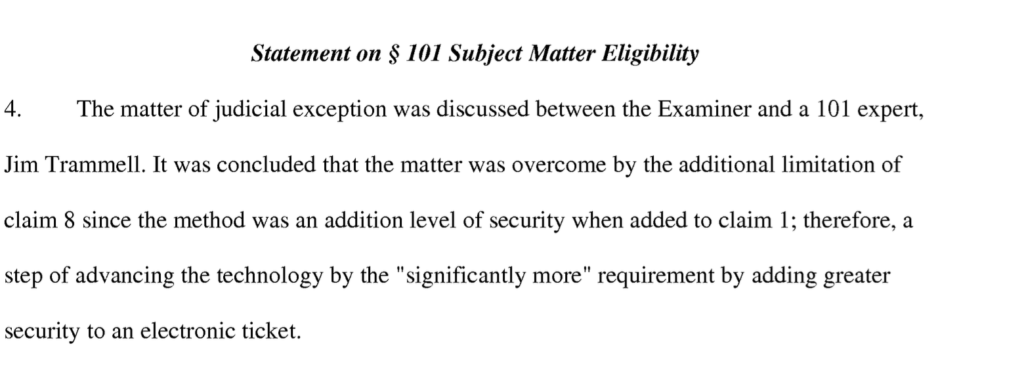The oral argument of the month is from NEVRO CORP. v. BOSTON SCIENTIFIC CORPORATION, No. 2018-2220 (Fed. Cir. Apr. 9, 2020). I liked this oral argument because the judges on the panel took a keen interest in how the language “configured to” should be construed for the patent at issue.
Another interesting issue was how the term “parasthesia-free” should be construed. I particularly found it interesting when there was a discussion of whether “parasthesia-free” should be treated the same as one of the boldest terms in patent law — “synergistically effective amount” — from the case Geneva Pharmaceuticals v. GlaxoSmithKline, 349 F.3d 1373 (Fed. Cir. 2003). In Geneva, the Federal Circuit stated:
By its terms, a “synergistically effective amount” is a functional limitation. As explained in In re Swinehart, 58 C.C.P.A. 1027, 439 F.2d 210, 213 (1971), a functional limitation covers all embodiments performing the recited function. Thus, this claim term should not be limited to the disclosed dosage range of 50 mg to 500 mg but instead should encompass any dosage amount that can achieve therapeutic synergy.
Geneva Pharmaceuticals v. GlaxoSmithKline, 349 F.3d 1373, 1384 (Fed. Cir. 2003)
The oral argument and the court’s opinion does not mention it; but, I was reminded of the Orthokinetics case as I listened to the oral argument. In Orthokinetics, the Federal Circuit stated:
The claims were intended to cover the use of the invention with various types of automobiles. That a particular chair on which the claims read may fit within some automobiles and not others is of no moment. The phrase “so dimensioned” is as accurate as the subject matter permits, automobiles being of various sizes. See Rosemont, Inc. v. Beckman Instruments, Inc., 727 F.2d 1540, 1547, 221 USPQ 1, 7 (Fed.Cir.1984). As long as those of ordinary skill in the art realized that the dimensions could be easily obtained, § 112, 2d ¶ requires nothing more. The patent law does not require that all possible lengths corresponding to the spaces in hundreds of different automobiles be listed in the patent, let alone that they be listed in the claims.
Orthokinetics, Inc. v. Safety Travel Chairs, Inc., 806 F.2d 1565, 1576 (Fed. Cir. 1986).
With respect to “configured to,” the Appellant argued that “configured to” meant “designed to” and cited In re Gianelli, Aspex Eyewear, and the In re Man Machine Interface Technologies LLC cases. In the Man Machine Interface case, for example, the Federal Circuit stated:
We have noted that the phrase “adapted to” generally means “made to,” “designed to,” or “configured to,” though it can also be used more broadly to mean “capable of” or “suitable for.” In re Giannelli, 739 F.3d 1375, 1379 (Fed.Cir.2014) (quoting Aspex Eyewear, Inc. v. Marchon Eyewear, Inc., 672 F.3d 1335, 1349 (Fed. Cir.2012) (referencing dictionaries)). Here, “adapted to,” as used in the ‘614 claims and specification, has the narrower meaning, viz., that the claimed remote control device is made or designed to be held in the human hand and the thumb switch is made or designed for activation by a human thumb.
In re Man Machine Interface Technologies LLC, 822 F.3d 1282, 1286 (Fed. Cir. 2016).
Also during the oral argument, Judge Taranto asked about the Core Wireless case. There is no discussion of Core Wireless in the opinion; but, I thought it still might be of interest:
Apple’s argument that its accused devices are always configured to operate in a variety of modes and to receive more than one TAV per multi-frame structure misses the mark. “[I]nfringement is not avoided merely because a non-infringing mode of operation is possible.” z4 Techs., Inc. v. Microsoft Corp., 507 F.3d 1340, 1350 (Fed. Cir. 2007); see also VirnetX, Inc. v. Cisco Sys., Inc., 767 F.3d 1308, 1322 (Fed. Cir. 2014). To take a simple example, a patent that claims an automobile configured to operate in third gear would be infringed by an automobile that is configured to operate in first, second, and third gears. The automobile is at all times configured to operate in any one of its possible gears, including the infringing one, even if the automobile is never driven in the infringing gear. Similarly, claim 14 is satisfied as long as Apple’s devices are configured to operate in a mode that receives a TAV only once per multi-frame structure and uses it for all channels.
Core Wireless Licensing SARL v. Apple Inc., 899 F.3d 1356, 1363 (Fed. Cir. 2018).
At the end of the day, the Nevro panel decided that for the patent at issue, “configured to” meant “programmed to” rather than “designed to.”
There was at least one other claim limitation in the opinion. It was analyzed as a means plus function limitation under 112, ¶6 (2006).
You can listen to the entire oral argument here:
You can review the court’s opinion here: [Link].
(I’ll have to look and see if anyone has ever used “synergistically effective configuration.”)
